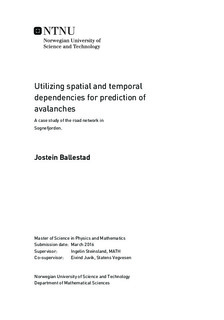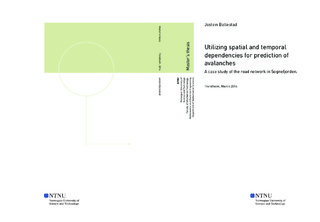| dc.description.abstract | Accurate prediction of avalanches is demanded to ensure safety along Norwegian roads during the winter season. On the initiative of Statens vegvesen (SVV), different statistical models has been tested, but have been found inadequate to properly explain the avalanches. Inspired by recent studies of the French Alps, we seek to find a better avalanche model by allowing separate stretches of road to share information.
In this case study, we used a data set comprising avalanche observations from the last 39 years in an area based around Sognefjorden in Norway. In addition, interpolations of the snow depth, based on the seNorge snow model, were used as explanatory variables for the different local avalanche sites. Different models were tested to evaluate the effect of utilizing spatial and temporal dependencies for prediction of avalanches, at a stretch of road-scale. The spatial and temporal dependencies were represented as explanatory variables in a Poisson regression model and as random effects in a latent Gaussian model (LGM) framework. Model inference and predictions were carried out using Poisson regression and integrated nested Laplace approximations (INLA) for the LGMs. The predictive performance of the various models was evaluated using different skill scores with cross validation for the Poisson regression models, and on a test set for the LGMs.
It was found that the inclusion of spatio-temporal explanatory variables improved the prediction accuracy of the Poisson regression model. However, the random effects in the more flexible latent Gaussian models were not found to strengthen the predictive performance. Overall, this implies that spatial and temporal dependencies can be exploited to improve avalanche models. Still, poor data quality was found to be a problem and more research is required to better understand the underlying spatio-temporal processes. | |

